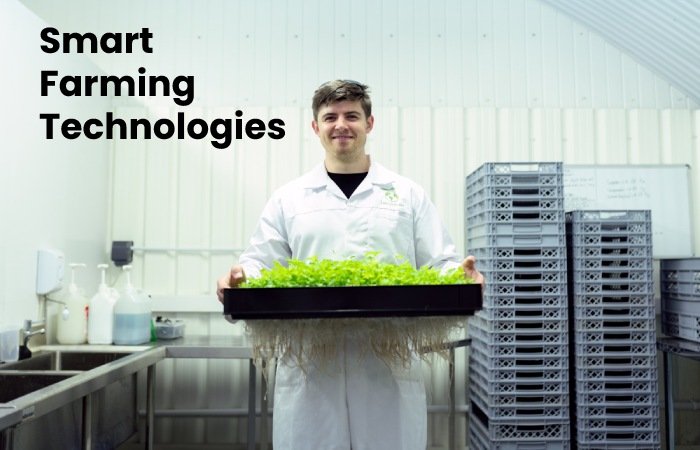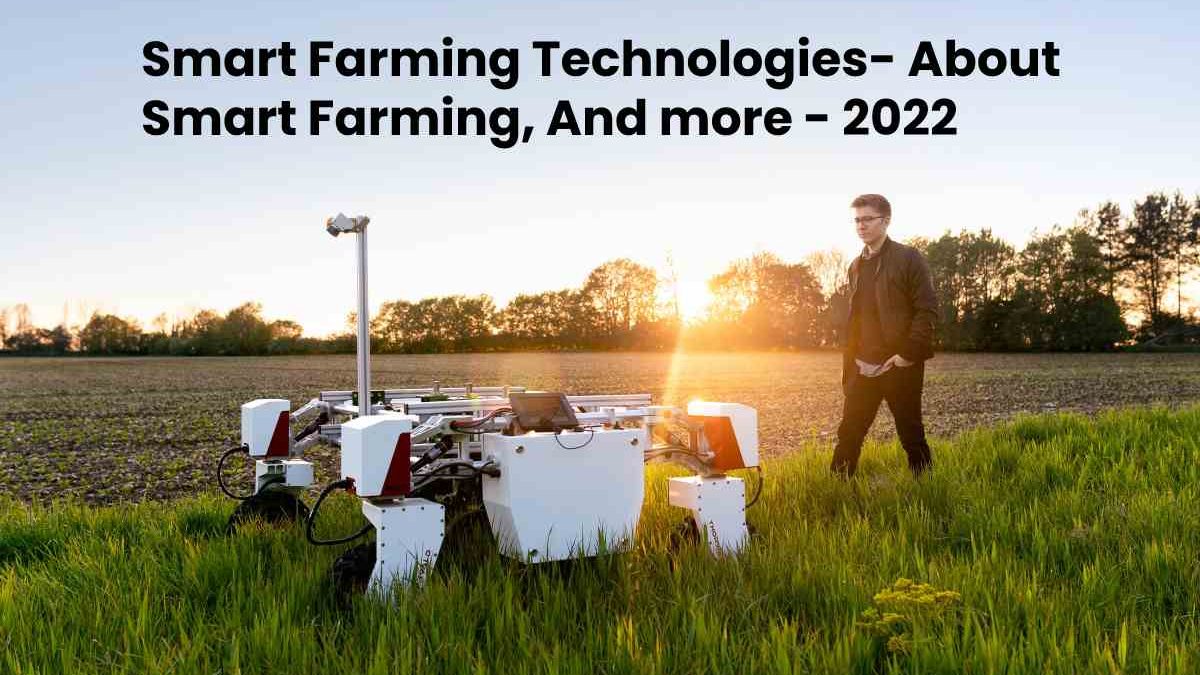Smart Farming Technologies Putting food on the table won’t be accessible if producers fail to deliver. Fortunately, revolutionary farming techniques are starting to bear fruit.

With population sizes expected to rise quickly in the following decades, will the world have enough to eat? It will depend on our ability to keep up with the food supply — and do so sustainably.
About Smart Farming Technologies, Based On IoT Applications
It responds to the challenge by integrating advanced technologies into current farming practices for better results. Perhaps you have come across bots or agricultural robots?
Equipped with sensors and IoT connectivity, these new automated workhorses can handle different parts of the farming process with remarkable efficiency and precision.
Tractors with computer vision and GPS navigation capabilities are designed to work day and night tirelessly. At the same time, seeding machines combining geo-mapping and sensor data can plant seeds at optimum depth and spacing.
Weeding robots with advanced machine learning functions can identify and remove weeds, whereas robots with cameras and precise algorithms can delicately harvest fruits without causing damage.
Impressive. It’s a giant leap from not too long ago when farmers could only count on themselves to carry labor-intensive tasks while at the mercy of uncoordinated logistics.
Still, one may wonder about the costs of machines taking over the fields and whether we might be looking at these innovations too positively.
Before going into the technological wonders that have made their way into agriculture, let’s go through the basics first.
What Is Smart Farming Technologies?
Smart farming refers to running a farm using advanced technologies to increase the quantity and quality of crops while reducing the amount of required human labor.
Innovative Farming Automates These For Farmers:
- Soil, water, light, humidity, and temperature management
- Crop monitoring via computers and mobile phones
- Harvest, fertilizer, and irrigation automation
Armed with sensors, robots, and other monitoring devices, today’s farmers can manage field conditions without going to the farm.
What Is the Internet of Food Smart Farming Technologies?
The Internet of Food (IoF) is a European Union (EU) project that aims to define and set up an infrastructure to allow the conditional sharing of data and models from various computational sources and data and model owners. It is spearheaded by the Institute for Sustainable Process Technology (ISPT).
It focuses on developing improved food production sensors to support the transition to more efficient and sustainable food industry. The project’s activities include:
- Sharing available and future data and models via a linked data infrastructure
- Making food-related data findable, accessible, interoperable, and reusable (FAIR)
- Agreeing on rules for successful data sharing among companies
- Gathering more valuable data, including new products, processes, and sustainability strategies
- NIZO: A leading company in contract research for better food and health.
- Symrise: A manufacturer of fragrances and flavors for consumer products.
- Eindhoven University of Technology (TU/e): A university that advances knowledge in science and technology for the benefit of humanity.
- Unilever: One of the world’s largest consumer goods companies.
- Wageningen University & Research (WUR): A university that aims to explore the potential of nature to improve the quality of life.
Smart Farming Technologies With A Crop Of Challenges
Yes, IoT is sowing the future of food production. But serious challenges are being encountered on the ground.
Connectivity
IoT connectivity poses a massive hurdle in remote locations where communication networks are inadequate or nonexistent. Failing to establish secure and reliable connections can negate the purpose of using IoT devices, Therefore these won’t be able to communicate as intended. Innovative farmers won’t know if their crops need tending without the necessary infrastructure.
Maintenance
After putting the necessary infrastructure in place, another challenge that needs to be addressed would be network maintenance. The communication network should work seamlessly to ensure the smooth flow of operations. And also if you think about it, And also the devices used in agriculture are exposed to harsh elements and may quickly get damaged. It is, thus, a must to come up with strategies to ensure sensors and other devices are well-maintained at all times.
Costs And Data Accuracy
Even where infrastructure is not an issue, And also IoT systems and the specialists required to maintain them are costly. The data collected is not always accurate — hardly providing farmers with the incentive to invest.
Environmental Factors
Then, what does mother nature have to say about all that? As bright as farming technologies might be, they have little to no means to influence environmental factors like droughts that render land unusable, storms destroying crops before they can be harvested, Therefore or climate change in general.
Ethics
Last but not least, the IoT industry has to contend with the socio-ethical questions. What happens to laborers whose ability to put food on their families’ tables is threatened by bots? What should be the role of governments in regulating, supporting, and limiting new farming practices? Can we trust machines to deal with every aspect of our alimentation?
Critical Factors For Successful Implementation Of IoT In Farming
- Making sure that IoT systems and devices are secure and can’t be manipulated or tampered with;
- Providing data security and privacy as part of data acquisition, storage, and management;
- Adding predictive analytics or machine learning functionalities to gain actionable insights from the connected devices;
- Ensuring machine interoperability for smooth communication.
To Further Raise The Chances Of Successful IoT Implementation For Farming Needs, You May Also Consider The Following Recommendations From IoT Development Experts:
- Applying an iterative approach to IoT solution development to ensure faster ROI: starting with a core feature set and expanding solution functionality. The iterative approach means breaking the process of developing an application into smaller parts and then creating it through repeated cycles.
- Using modular IoT architecture to simplify solution maintenance and vertical and horizontal architecture expansion. Modular architecture refers to the design of systems composed of separate components (modules) that can connect.
- Leveraging cloud services to reduce infrastructure costs and speed up development.
Smart Farming Applications
Despite its impact on human labor, smart farming is proving its worth in raising productivity through innovative applications
Precision Farming
- IoT sensors on the ground, in the water, And also or aboard vehicles control crop production and livestock raising.
- Farmers access data collect from the field through low-cost satellite feeds and sensors using tablets and smartphones.
Agricultural drones
- Agricultural drones keep an eye on the fields and installations and help manage large farms with vast plantations or herds.
- Airborne sensors collect visual and thermal data for surveying, mapping, and monitoring crops and field conditions.
Livestock monitoring
- Sensors identify sick animals enabling farmers to quickly separate them from the herd and prevent the spread of disease.
- Sensors can detect when a pregnant animal’s water has broken and alert ranchers to be on hand for medical support.
Smart Greenhouses
- Solar-powered sensors enable farmers to monitor greenhouse conditions, And also including water consumption, light, temperature, and humidity.
- Farmers can remotely turn on the lights, And also open a window, activate a fan, lower or increase the heat, or activate misters.
Smart Irrigation
- Sensors installed on water channels activate the flow into furrows or ditches Therefore as soil conditions require.
- Sprinkler systems with intruder alert function are automatically activate when sensors detect unauthorized. And also individuals or animals within the irrigated area.
Farm Management Systems
- Automatic systems collect and process data on the work perform in the fields or farm installations.
- Sensors are connect to the Internet. And also collect data is store on cloud servers and becomes accessible from various devices and applications.
The idea behind intelligent farming is taking root in many parts of the world as the clamor for food security intensifies. And also It could be part of our strategy for survival — or an undertaking that won’t bear much fruit in the foreseable future.


